Material Concerns
-
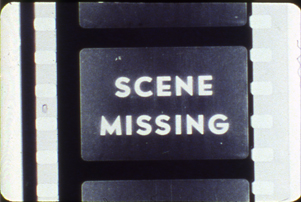 Standard Gauge (1984) by Morgan Fisher
Standard Gauge (1984) by Morgan Fisher
-
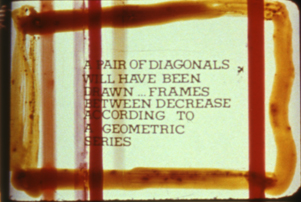 Future Perfect (1978) by Roberta Friedman & Grahame Weinbren
Future Perfect (1978) by Roberta Friedman & Grahame Weinbren
-
 Screen (1969) by Pat O'Neill
Screen (1969) by Pat O'Neill
-
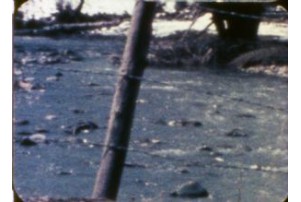 Stasis, by David Wilson
Stasis, by David Wilson
-
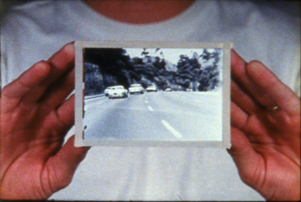 Pasadena Freeway Stills (1974) by Gary Beydler
Pasadena Freeway Stills (1974) by Gary Beydler
-
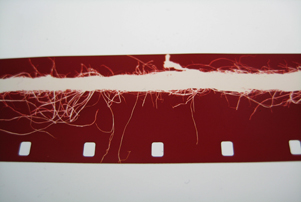 Photogrammetry Series (1977) by Louis Hock
Photogrammetry Series (1977) by Louis Hock
-
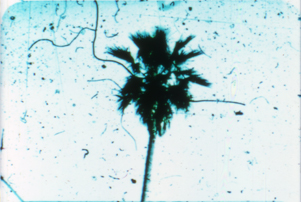 Venusville (1973) by Chris Langdon and Fred Worden
Venusville (1973) by Chris Langdon and Fred Worden
March 4, 2012, 7:30PM
Spielberg Theater at the Egyptian, 6712 Hollywood Blvd., Los Angeles CA 90028
One of the key concerns of experimental film, in the tradition of all modern art, is the stuff of film itself: how it is made, what is it made of, what are the basic elements of the camera, the celluloid, and the projector.
In experimental film, focusing on the materials and procures of film-making has come to be known as structuralist film-making, with a hey-day from the late 1960s through the mid-1970s, but continuing in much work today. These are several classic examples made in Los Angeles, with precise control over the instruments of filmmaking, the depth of good art, and (more often than not) a fair dose of wit.
Tickets: General $10, Students/seniors $6; free for Filmforum members
Advance ticket purchase available through Brown Paper Tickets.
Films to be Screened
-
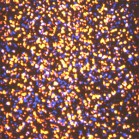 Screen (1969) by Pat O'Neill
Screen (1969) by Pat O'Neill
Screen (1969, digital (originally 16mm), color, silent, 4 min.)
Directed by Pat O'Neill“’Screen’ was installed in the Wight Galleries at UCLA in January 1969 as a part of the exhibition “Electric Art”. It was back-projected through a square opening into a darkened room. The projected image was a 16mm Kodachrome print, looped, three and a half minutes in duration.
“The image was made, initially, by spray painting a pattern of random dots on a strip of clear 16mm leader. The resulting film was contact printed on black and white stock to make several masters, which were subsequently optically printed, using colored gels, to color stock. My intent was to generate a series of moving color images, all based on the same original few seconds of cameraless “picture”. I was interested in the apparent motion arising from a totally random field. In some of these images, clusters of ragged shapes appear to rotate or form circular channels. None of these were planned or anticipated. The square format was chosen in order to avoid some learned response to the cinema screen.” (Pat O'Neill)
-
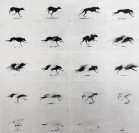 Accident, by Jules Engel
Accident, by Jules Engel
Accident (1973, 16mm, b/w, sound, 3min.)
Directed by Jules EngelPrint courtesy of Center for Visual Music
“Accident... shows a simple animated drawing of a running dog, looped so that it resembles an image seen in a Zoetrope or in a Muybridge experiment.” (David James "The Most Typical Avant-Garde", 2005)
-
 Venusville (1973) by Chris Langdon and Fred Worden
Venusville (1973) by Chris Langdon and Fred Worden
Venusville (1973, 16mm, color, sound, 10min.)
Directed by Chris Langdon and Fred WordenRestored print from the Academy Film Archive.
“No montage, no human subjects, minimal visual content, and the artists basically pissing on the fourth wall by calling attention in every way possible to the artifice of what they're doing. An anti-film school film made at film school.” (Mark Toscano)
-
 Photogrammetry Series (1977) by Louis Hock
Photogrammetry Series (1977) by Louis Hock
Photogrammetry Series (1977, 16mm, color, sound, 8 min.)
Directed by Louis HockIn a completely dark gymnasium, Louis Hock unspooled dozens of feet of 16mm color print stock along the different dimensions of the space, laying equal lengths of gnarly twine on top of it. One brief flash of the gymnasium’s lights later, the resulting film functions as an abstract map of the location, a record of a performance, and an unusual meditation on the objecthood of film. The image, a vertical, negative shadow of the twine’s presence, unspools over time, with occasional bursts of sound that occur when the twine image slides over into the soundtrack area of the film.
-
 Pasadena Freeway Stills, by Gary Beydler
Pasadena Freeway Stills, by Gary Beydler
Pasadena Freeway Stills (1974, 16mm, color, silent, 5.5min.)
Directed by Gary BeydlerRestored print from the Academy Film Archive.
"Possibly the most lucid, vivid, and awesome demonstration of the building up of still images to create moving ones, Pasadena Freeway Stills simply, gracefully and powerfully shows us the process by which we are fooled by the movies.” (Mark Toscano)
-
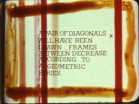 Future Perfect (1978) by Roberta Friedman and Grahame Weinbren
Future Perfect (1978) by Roberta Friedman and Grahame Weinbren
Future Perfect (1978, 16mm, color, sound, 11 min.)
Directed by Grahame Weinbren and Roberta FriedmanRestored print from the Academy Film Archive.
A camera follows a map through a defined space, while markings representing the camera’s movements appear on the film strip itself with increasing frequency.
"A film which, always unfinished, looks forward to a future when it (and everything else) will be perfect." (Roberta Friedman & Grahame Weinbren)
-
 Stasis, by David Wilson
Stasis, by David Wilson
Stasis (1976, 16mm, color, sound, 8min.)
Directed by David WilsonRestored print from the Academy Film Archive.
The original camera footage for Stasis is an 8-minute, 8:1 camera zoom. That footage was then printed with an equal but complimentary optical zoom resulting in an image of apparent stillness. Stasis is the image of the stillness in motion. Stasis counterpoints the movements of running water in a stream within a still-camera shot, with a steady zoom from without the filmed image (including subtle sprocket holes and frame lines) to a close-up within the image.
“A zoom-out camera shot of a stream in Western Colorado is compensated for by a reverse zoom in rephotography. The tension between these movements creates a drama and a commentary on cinematic illusionism.” (Roberta Friedman)
-
Picture Without Sound (1976, 16mm, color, silent 24fps, 4.5min.)
Directed by Susan Rosenfeld"Picture Without Sound is a film composed of variations on three basic shots that are organized in a pattern signified by the notation a1b1c1a2b2c2a3b3c3a4. Although the ten shots are joined by non-matching cuts, members of each triad are interlinked by the appearance of the same object in adjacent shots. Repetition is a method of approaching the definition of qualities that do not reveal themselves in a single aspect." (Susan Rosenfeld) -
I Kiss the Dear Fingers So Toil-Worn For Me (1981) by Craig Rice
I Kiss the Dear Fingers So Toil-Worn For Me (1981, 16mm, b/w, silent, 5.5min.)
Directed by Craig RiceA "cameraless" film, developed in the bathtub and dried on a clothesline. (Craig Rice)
-
 Standard Gauge (1984) by Morgan Fisher
Standard Gauge (1984) by Morgan Fisher
Standard Gauge (1984, 16mm, color, sound, 35min.)
Directed by Morgan Fisher“A frame of frames, a piece of pieces, a length of lengths. Standard gauge on substandard; narrower, yes, but longer. An ECU that’s an ELS. Disjecta membra; Hollywood anthologized. A kind of autobiography of its maker, a kind of history of the institution of whose shards it is composed, the commercial motion picture industry. A mutual interrogation between 35mm and 16mm, the gauge of Hollywood and the gauge of the amateur and independent.” (Morgan Fisher)